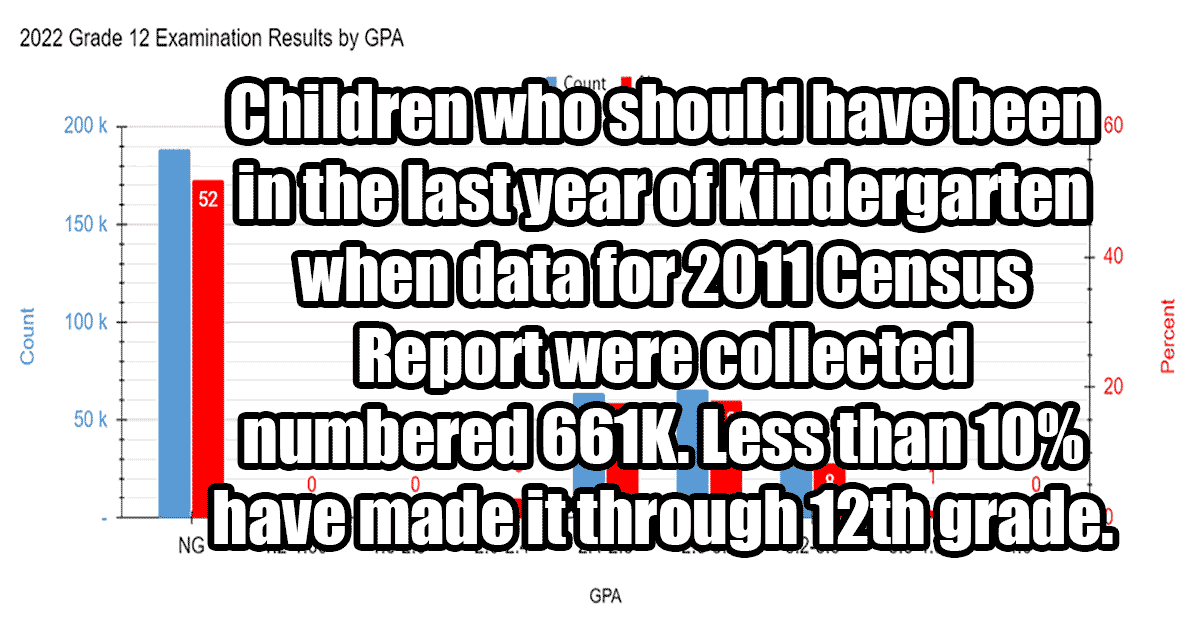
By all account, the education system in Nepal is the most corrupt system in the country. While, therefore, the system has been bleeding and wasting the State’s resources, the more I learn about it, I keep wondering if, being so corrupt, its aim is to actually put students through a wringer.
Truly, I seriously wonder if the purpose of Nepal’s education system is to fail the students and punish them for the rest of their lives for failing instead of to educate them, to prepare them for — and to make something of — their lives! Yes, I know crazy, right?! And I don’t say that lightly.
Furthermore, I say that because I am deeply and profoundly concerned for — and worry about — education in general and specifically of Nepali children, the likes of my little nephew! The results and consequences, on the population, of the failure of the past seventy or so years of education is clearly visible in the Nepali society, for those willing to delve a little deeper.
Let’s start with the grade 12 national level examination results published last month: they were horrendous, again! Apparently, a whopping 52% — a majority — of the candidates are “not qualified to continue their education” (“NG” in the chart below). “Not qualified”, by the way, is euphemism for “failed.” Furthermore, NO candidate scored the highest (4 GPA), no different from last year’s results.
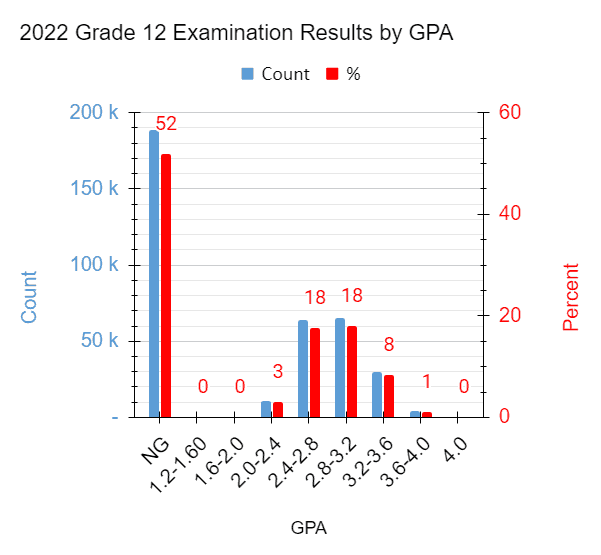
These results are NOT just one-off case. In other words, the explanation is NOT that this year’s examination was an exceptionally difficult one. The Kathmandu Post reports that the pass rates have been “hovering below 50 percent for years.” (If you are interested, Edusanjal in this article has detailed analysis of grade 12 examination results for the years 2075-2077 BS (2018-2020 AD).)
In the article, The Post, of course, also points out the obvious it likely has always done like clockwork every single year following the publication of results such as this one: “[it] has raised many questions over Nepal’s education sector and once again put the spotlight on the utter failure of all concerned to improve the country’s school education system over the years.”
School students in Nepal also take a national level examination at the end of grade 10, called Secondary Education Examination (SEE), the results of which are no better either. When I was a students in the 1980’s, it was called School Leaving Certificate, and the year I took it, 75% failed it. From 2012 to 2014, the failure rate was over 50%! Analysis of the 2019 results in Setopati found the failure rate to be 60%!
So what’s the most recent and significant reform the concerned authorities have implemented? They changed the grading system — from numbers to letter grades in all the national level examinations! Of course, not surprisingly, that didn’t address the problem at all. You’d have to be a fool to think and believe that changing just the grading system would in any way or to any significant extent. Failure rates — “Not Qualified” grades now — have continued to still be unacceptably high. In other words, every year following a national level examination, about half the candidates are being told that they are “not smart enough” to pursue further studies. The end result? A vastly uneducated population!
Let’s zero in on the cohorts who took the grade 12 examinations this year. Let’s call them the Class of 2022. Let’s assume the cohort were five-year-old kindergartners when the data for the 2011 Census Report were collected in 2009-10. They numbered 661K.
The cohort took their SEE in 2020, following major disruptions and hindrances to their education: the earthquakes of April 25 and May 12 in 2015 and, to some extent, the coronavirus pandemic. No different from any other such examination, candidates include first timers (Regulars) and the repeats (referred to as Supplementary and Exempted).
Unfortunately, the only source I found which broke down the SEE candidates into those categories is some GBS-Notes. Their total does NOT match that of Kathmandu Post‘s (482K), however. Regardless, according to them, in 2020, Regular candidates numbered 405450.
Of course, apart from the Class of 2022 candidates, the Regulars would have included candidates who joined school earlier but, even after falling behind in their studies along the way, made it through to 10th grade and took the SEE. They would have also included those that followed an accelerated program because they were gifted, for example. What that also means is that, not all the Regulars that passed SEE necessarily belonged to the Class of 2022.
Not knowing anything about those numbers and assuming ALL the Regulars (405450) belonged to the Class of 2022, 61.3% of them made it to 10th grade! That rate is likely off — rather inflated — for other reasons too. How off you might get a better sense for from what The Himalayan Times has to say, and I quote,
“School education has been operating, but its indicators are not encouraging. Almost 3.4 and 7.7 per cent of the school-going population are outside the school in primary and basic education. At the secondary level, the situation is still more depressive. Only 54 per cent of the students carry on at this level. About 43 per cent of the students quit their studies without reaching the tenth standard.”
In an attempt to get a better estimate for the rate completing secondary school, let’s assume firstly, all members of the cohorts went to school AND only 40% quit school before tenth grade, instead of 43% as noted by The Times. The 61.3% rate of Class of 2022 making it all the way to 10th grade then drops to 60.0%.
Next, of the 405450 Regular candidates, GBS-Notes reports, 193832 passed it. For argument’s sake, let’s just assume that all those who passed represent Class of 2022, which of course is NOT true. Regardless, 194K of the cohorts would have qualified to continue on to 11th grade — Higher Secondary Education (HSE). That is, only 29.3% of the cohorts could have potentially continued on with their education.
Again, for lack of any indicators, let’s assume that ALL 194K members of the Class of 2022 did continue their education. According to The Himalayan Times, “83 per cent of the students leave school in 12th standard.” Instead of 83%, let’s assume the total who quit over the course of the two years was only 50%. We are then left with 97K of the Class of 2022 showing up to the grade 12 examination. (Their HSE was also disrupted — this time by the coronavirus pandemic. Additionally, 363K were reported to have appeared for the examination this year. Of course, they also include candidates who completed SEE before 2020 but started the course late and/or who repeated the examination etc.)
Let’s further assume that the failure rate of the Class of 2022 and the rest are exactly the same as that of the total, just for argument’s sake again. In other words, 52% of the 96K also failed. The number that graduated is therefore 47K.
In other words, of the 661K who were in the last year of kindergarten in 2009-10, 47K (7.0%) in 2022 graduated from school and can avail themselves of further education opportunities. The actual percent is likely lower! But, even if the numbers were twice as high (14%), as you can see, our schooling fails a vast majority of the students.
Is it any wonder then that, according to the 2011 Census Report, only about 6.88% of the population have twelve or more years of education?! (When the 2021 Census Report is published, I would love to find out how that has changed.)
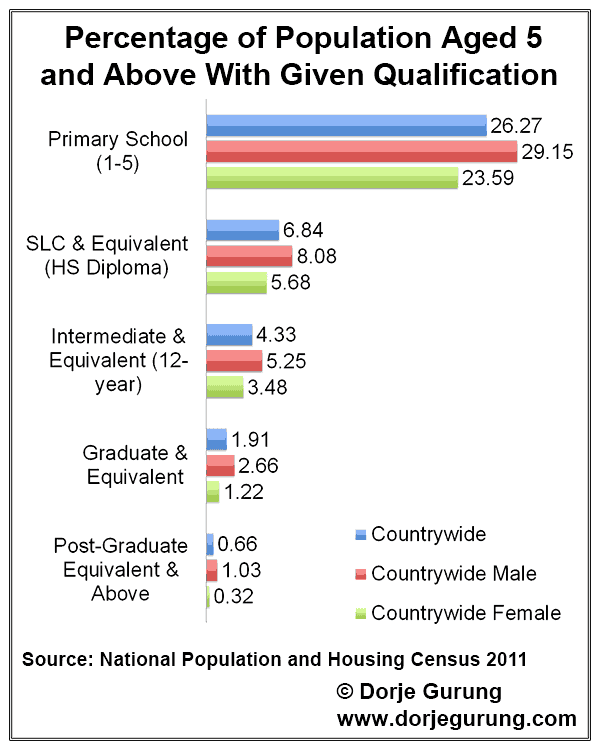
The following graphs chart the population who were “absent” according to the last three census reports — 2001, 2011, and 2021. That is, the population who were abroad, most of whom send money home. (As a matter of fact, the economy of the country is heavily reliant on remittances.)
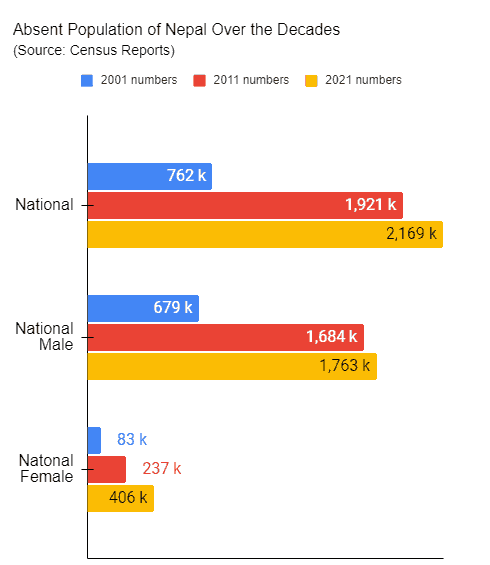
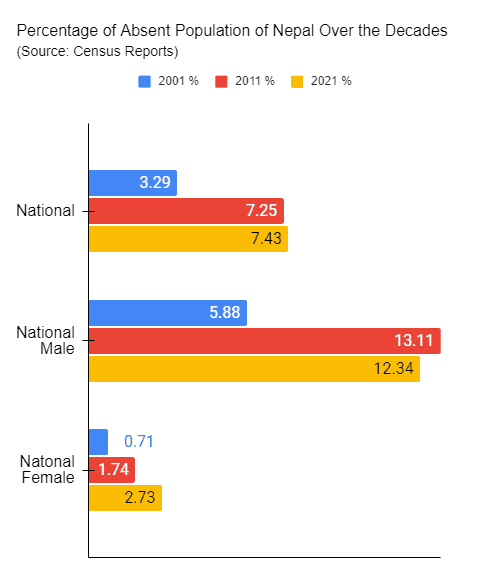
In the absence of disaggregated data, I am willing to bet that firstly, a disproportionately high percentage of the “absent” population are 18-35 year-olds AND, secondly, within that demographics, MULTIPLE times more 18-35 year-olds are toiling away — and suffering — as unskilled or semi-skilled migrant worker than those pursuing further studies and/or engaged in professional work in line with their academic qualifications.
Returning to the 7.0% of the Class of 2022, here are some important questions about them.
- What percent will enroll in an undergraduate program in the country and continue their education? What percent abroad?
- Following that, what percent will obtain advanced degrees such as Bachelor’s, Master’s, and PhD?
- What percent will make something of their life through their qualification?
I believe they will be insignificantly small. They have ALWAYS been so in the past.
Now, here are the two most important question about the graduates:
- What percent will go on to live fulfilling, dignified lives?
- What percent will go on to live lives in which they feel that they have been able to attempt — or have had the opportunity — to reach/accomplish their human potential?
As condescending or patronizing as it may sound, I suspect those are NOT even consideration or in the radar of a vast majority of Nepalis, and, therefore, most don’t or won’t think about them, forget attempt to realize them. Of course, I could be wrong.
And finally, two questions about the 93% of the Class of 2022 cohort that didn’t graduate.
- What percent get any opportunity to live a fulfilling or a dignified life?
- What percent will come to recognize and understand that, had it NOT been for our totally screwed up education system, they could potentially have become or achieved much more in life instead of having to toil away in some far off land enduring unbearable heat and abuse, like in Qatar?
The answer to both? A disturbingly low percentage, I am pretty sure.
To the educator in me, those are some acutely depressing and maddening aspects of being citizens of Nepal. Worse still, no different from the generations before them, a vast majority of 661K Class of 2022 will likely come to believe that what they got in life — whether as a direct or indirect consequence of their failure in academics — was all they were capable of. That is, a majority will likely blame themselves. Or, they will likely believe (and explain) the limited opportunities they got in life, or the little they got from life, was (a result of) what God or Karma intended, or was simply their destiny.
Those are the many intangible ways the people and country of Nepal are paying for the deeply corrupt education system.
What’s the solution? Our system needs a COMPLETE overhaul. We need to scrape homework and examinations for primary school children, scrap local level examination in grade 8, and national level examination in grade 10, scrap textbooks, among other things. Stress reading from pre-school and instill a reading habit in children. Of course, there’s massive problems with the teaching profession too which also requires a complete overhaul.
What do you think?
(This blog draws from a May 4, 2020 Instagram post and an Aug. 2, 2022 Twitter thread.)
